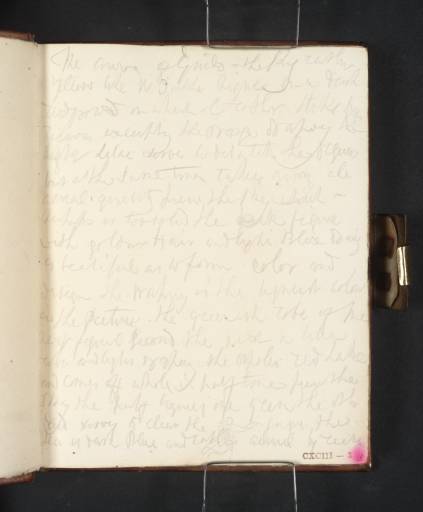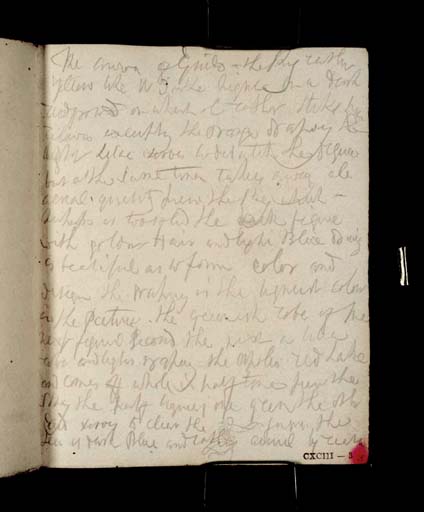Joseph Mallord William Turner Notes on the 'Aurora' by Guido Reni, in the Palazzo Pallavicini-Rospigliosi, Rome 1819
Image 1 of 2
Joseph Mallord William Turner,
Notes on the 'Aurora' by Guido Reni, in the Palazzo Pallavicini-Rospigliosi, Rome
1819
Joseph Mallord William Turner 1775–1851
Folio 4 Recto:
Notes on the ‘Aurora’ by Guido Reni, in the Palazzo Pallavicini-Rospigliosi, Rome 1819
D16766
Turner Bequest CXCIII 3
Turner Bequest CXCIII 3
Pencil on white wove paper, 115 x 94 mm
Inscribed by the artist in pencil (see main catalogue entry)
Inscribed by John Ruskin in red ink ‘3’ bottom right
Stamped in black ‘CXCIII 3’ bottom right
Inscribed by John Ruskin in red ink ‘3’ bottom right
Stamped in black ‘CXCIII 3’ bottom right
Accepted by the nation as part of the Turner Bequest 1856
References
1909
A.J. Finberg, A Complete Inventory of the Drawings of the Turner Bequest, London 1909, vol.I, p.574, as ‘ “The Aurora of Guido [in the hall of the Rospigliosi Palace] – the sky rather yellow like ... Light on a dark red ground on which he stiks his relievo excepting the orange drapery. The light lilac serves to detach the figure, but at the same time takes away all aerial quality from the sky which perhaps is too solid. The dark figure with golden Hair and light blue drapery is beautiful as to form, color and design. The drapery is the lightest colour in the picture, the greenish robe of the next figure second, the next a lilac robe and light drapery. The Apollo red Lake and comes off whole.: half is tone from the sky, &c.” ’.
1925
Thomas Ashby, Turner’s Visions of Rome, London and New York 1925, p.15.
1969
John Gage, Colour in Turner: Poetry and Truth, London 1969, pp.143, 259 note 75, 272 note 24.
1979
Andrew Wilton, J.M.W. Turner: His Life and Work, Fribourg 1979, pp.139 and 151 note 15.
1984
Cecilia Powell, ‘Turner on Classic Ground: His Visits to Central and Southern Italy and Related Paintings and Drawings’, unpublished Ph.D thesis, Courtauld Institute of Art, University of London 1984, pp.145 note 79, 151 and 484 note 1.
1987
Cecilia Powell, Turner in the South: Rome, Naples, Florence, New Haven and London 1987, pp.59, 65, [67], 203 notes 1, 17 and 44.
2001
Cecilia Powell, ‘Guido Reni’, in Evelyn Joll, Martin Butlin and Luke Herrmann (eds.), The Oxford Companion to J.M.W. Turner, Oxford 2001, p.257.
As Finberg first identified, the handwritten inscription on this page refers to the Aurora of Guido Reni (1575–1642), a fresco dating from 1613–14 which decorates the ceiling of the Casino dell’Aurora in the Palazzo Pallavicini-Rospigliosi, Rome.1 Turner’s notes read as follows:
The Aurora of Guido – the sky rather | yellow like W Smoke Light on a Dark | red ground on which [?G] rather stiks his | Relievo excepting the orange drapery the | light Lilac serves to detach the figure | but at the same time takes away all | aerial quality from the sky which | perhaps is too solid the Dark figure | with golden Hair and light Blue Drapery | is beautiful as to form, color and | design the Drapery is the lightest colour | in the picture. the greenish robe | of the next figure second the next a lilac | robe and light drapery the Apollo red Lake | and comes off whole .: half tone from the | sky the half figures one green the other | red serves to clear the [sketch of figure] [?figures] the | Sea is dark Blue and rather aerial by [?reason]2
The Aurora is one of Guido Reni’s most famous works and during the nineteenth century was much admired for its colouring and use of landscape. Charlotte Eaton, for example, in her popular travel guide book Rome in the Nineteenth Century, first published in 1820, wrote:
On the roof of the summer-house of the Palazzo Rospigliosi, is painted the celebrated fresco of Guido’s Aurora. Its colouring is clear, harmonious, airy, brilliant – unfaded by time; and the enthusiastic admirer of Guido’s genius may be permitted to hope, that this, his noblest work, will be immortal as his fame.4
Turner himself would have already been familiar with Reni’s composition from engravings and referred to it in one of his Perspective Lectures given to the Royal Academy from 1818.5 However, the experience of seeing the fresco’s celebrated colouring first-hand moved him to make extensive notes on the tonal and perspectival effects. As is characteristic of his attitude to the Old Masters, his comments are both admiring and critical. He has condemned the aerial qualities of the landscape, but found much to appreciate in the drawing and colour harmonies of the draperies.6 Powell has suggested that Reni’s depiction of the boy, Phosphorus, accompanying the figure of the dawn goddess Aurora, may have been an iconographical source of inspiration for the phosphorescent nymphs in his later oil painting, Ulysses Deriding Polyphemus exhibited 1829 (National Gallery, London).7
Copies of paintings by Claude from the collection of the Palazzo Pallavicini-Rospigliosi can be seen on folio 82 (D165850; Turner Bequest CXCIII 81).
Nicola Moorby
February 2011
How to cite
Nicola Moorby, ‘Notes on the ‘Aurora’ by Guido Reni, in the Palazzo Pallavicini-Rospigliosi, Rome 1819 by Joseph Mallord William Turner’, catalogue entry, February 2011, in David Blayney Brown (ed.), J.M.W. Turner: Sketchbooks, Drawings and Watercolours, Tate Research Publication, December 2012, https://www


